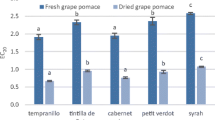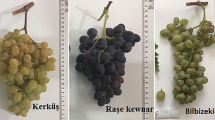Abstract
One of the biggest hurdles faced by the wine industry is the disposal of residual biomass generated after vinification. Although this residue is biodegradable, it constitutes a potential source of environmental pollutants. To alleviate this issue, this biomass may be used in alternative applications; for example, it may be transformed into an enriched flour that can be used to improve the nutrient content in different foods. In this study, were evaluated the effects of drying processes on the relevant nutritional components in dry extracts obtained from the residue of fermented grape pomace. The concentrations of phenolic compounds and anthocyanins were higher when drying the flour by the traditional oven procedure than by freeze-drying. The highest difference (approximately 40%) was observed for tannin compounds. Therefore, drying in an oven is recommended due to the lower loss of bioactive compounds, in addition to being simple and cheap.

Similar content being viewed by others
Availability of data and material
Not applicable.
Code availability
Not applicable.
References
Abarghuei MJ, Rouzbehan Y, Alipour D (2015). The effect of tannins in grape pomace and oak leaf on the in vitro organic matter digestibility and in situ disappearance of sheep
Acosta-Estrada BA, Gutiérrez-Uribe JA, Serna-Saldívar SO (2014) Bound phenolics in foods, a review. Food Chem 152:46–55
Akyuva Y, Nazıroğlu M (2020) Resveratrol attenuates hypoxia-induced neuronal cell death, inflammation and mitochondrial oxidative stress by modulation of TRPM2 channel. Sci Rep 10(1):1–16
Alipour D, Rouzbehan Y (2007) Effects of ensiling grape pomace and addition of polyethylene glycol on in vitro gas production and microbial biomass yield. Anim Feed Sci Technol 137(1–2):138–149
Association of Official Analytical Chemists (AOAC) (2005) AOAC official method 2005.02 total monometric anthocyanin pigment content of fruit juices, beverages, natural colorants, and wines. In: Official methods of analysis of AOAC International, 18th edn. AOAC, Gaithersburg
Barcia MT, Pertuzatti PB, Gómez-Alonso S, Godoy HT, Hermosín-Gutiérrez I (2014) Phenolic composition of grape and winemaking by-products of Brazilian hybrid cultivars BRS Violeta and BRS Lorena. Food Chem 159:95–105
Bennemann GD, de Assis CF, Moreira GCRC, de Lima LH, Carvalho KK, Torres YR, Botelho RV (2016). Mineral analysis, anthocyanins and phenolic compounds in wine residues flour. In: BIO Web of Conferences, vol. 7, p. 04007. EDP Sciences.
Beres C, Freitas SP, de Oliveira Godoy RL, de Oliveira DCR, Deliza R, Iacomini M, Mellinger-Silva C, Cabral LMC (2019) Antioxidant dietary fibre from grape pomace flour or extract: Does it make any difference on the nutritional and functional value? J. Funct Foods 56:276–285
Botelho T, Costa M, Wilk M, Magdziarz A (2018) Evaluation of the combustion characteristics of raw and torrefied grape pomace in a thermogravimetric analyzer and in a drop tube furnace. Fuel 212:95–100
Breuss JM, Atanasov AG, Uhrin P (2019) Resveratrol and its effects on the vascular system. Int J Mol Sci 20(7):1523
Brezoiu AM, Matei C, Deaconu M, Stanciuc AM, Trifan A, Gaspar-Pintiliescu A, Berger D (2019) Polyphenols extract from grape pomace Characterization and valorisation through encapsulation into mesoporous silica-type matrices. Food Chem Toxicol 133:110787
Careri M, Corradini C, Elviri L, Nicoletti I, Zagnoni I (2003) Direct HPLC analysis of quercetin and trans-resveratrol in red wine, grape, and winemaking byproducts. J Agric Food Chem 51(18):5226–5231
CONAB Companhia Nacional de Abastecimento. (2019) Análise mensal, Uva Industrial. www.conab.gov.br. Accessed 20 July 2020
Çoklar H, Akbulut M (2017) Effect of sun, oven and freeze-drying on anthocyanins, phenolic compounds and antioxidant activity of black grape (Ekşikara) (Vitis vinifera L.). South African J Enol Vitic 38(2):264–272
Fuleki T, Francis FJ (1968) Quantitative methods for anthocyanins. 1. Extraction and determination of total anthocyanin in cranberries. J Food Sci 33(1):72–77
He J, Giusti MM (2010) Anthocyanins: natural colorants with health-promoting properties. Annu Rev Food Sci Technol 1:163–187
Larrauri JA, Rupérez P, Saura-Calixto F (1997) Effect of drying temperature on the stability of polyphenols and antioxidant activity of red grape pomace peels. J Agric Food Chem 45(4):1390–1393
Lila MA, Burton-Freeman B, Grace M, Kalt W (2016) Unraveling anthocyanin bioavailability for human health. Annu Rev Food Sci Technol 7:375–393
Pojer E, Mattivi F, Johnson D, Stockley CS (2013) The case for anthocyanin consumption to promote human health: a review. Compr Rev Food Sci Food Saf 12(5):483–508
Price ML, Hagerman AE, Butler LG (1980) Tannin content of cowpeas, chickpeas, pigeon peas, and mung beans. J Agric Food Chem 28(2):459–461
Rani J, Rautela A, Kumar S (2020) Biovalorization of winery industry waste to produce value-added products. In: Biovalorisation of Wastes to Renewable Chemicals and Biofuels (pp. 63–85). Elsevier
Ribeiro de Lima MT, Waffo-Téguo P, Teissedre PL, Pujolas A, Vercauteren J, Cabanis JC, Mérillon JM (1999) Determination of stilbenes (trans-astringin, cis-and trans-piceid, and cis-and trans-resveratrol) in Portuguese wines. J Agric Food Chem 47(7):2666–2670
Rockenbach II, Rodrigues E, Gonzaga LV, Caliari V, Genovese MI, Gonçalves AEDSS, Fett R (2011) Phenolic compounds content and antioxidant activity in pomace from selected red grapes (Vitis vinifera L. and Vitis labrusca L.) widely produced in Brazil. Food Chem 127(1):174–179
Salehi B, Mishra AP, Nigam M, Sener B, Kilic M, Sharifi-Rad M, Fokou PV, Martins N, Sharifi-Rad J (2018) Resveratrol: A double-edged sword in health benefits. Biomedicines 6(3):91
Schlich M, Lai F, Pireddu R, Pini E, Ailuno G, Fadda AM, Valenti D, Sinico C (2020) Resveratrol proniosomes as a convenient nanoingredient for functional food. Food Chem 310:125950
Serrano J, Puupponen-Pimiä R, Dauer A, Aura AM, Saura-Calixto F (2009) Tannins: current knowledge of food sources, intake, bioavailability and biological effects. Mol Nutr Food Res 53(S2):S310–S329
Silva V, Igrejas G, Falco V, Santos TP, Torres C, Oliveira AM, Pereira JE, Amaral JS, Poeta P (2018) Chemical composition, antioxidant and antimicrobial activity of phenolic compounds extracted from wine industry by-products. Food Control 92:516–522
Singleton VL, Orthofer R, Lamuela-Raventós RM (1999) Analysis of total phenols and other oxidation substrates and antioxidants by means of folin-ciocalteu reagent. Methods Enzymol 299:152–178
Souto AA, Carneiro MC, Seferin M, Senna MJ, Conz A, Gobbi K (2001) Determination of trans-resveratrol concentrations in Brazilian red wines by HPLC. J Food Compos Anal 14(4):441–445
Tsuda T (2012) Dietary anthocyanin-rich plants: biochemical basis and recent progress in health benefits studies. Mol Nutr Food Res 56(1):159–170
Acknowledgements
The authors acknowledge the financial support from the Brazilian Government Agencies including the Coordination for the Improvement of Higher Education Personnel—Brazil (CAPES) and São Paulo Research Foundation (FAPESP—Grant 2018/24029-1).
Funding
Financial support from the Brazilian Government Agencies including the Coordination for the Improvement of Higher Education Personnel (CAPES) and São Paulo Research Foundation (FAPESP - Grant 2018/24029-1).
Author information
Authors and Affiliations
Corresponding author
Ethics declarations
Conflict of interest
The authors declare no conflicts of interest.
Additional declarations for articles in life science journals that report the results of studies involving humans and/or animals
Not applicable.
Ethics approval
Not applicable
Consent to participate
Not applicable.
Consent for publication
Not applicable.
Additional information
Publisher's Note
Springer Nature remains neutral with regard to jurisdictional claims in published maps and institutional affiliations.
Rights and permissions
About this article
Cite this article
Pires, J.A., Gomes, W.P.C., Teixeira, N.N. et al. Effect of drying methods on nutritional constitutes of fermented grape residue. J Food Sci Technol 59, 3458–3463 (2022). https://doi.org/10.1007/s13197-021-05334-8
Revised:
Accepted:
Published:
Issue Date:
DOI: https://doi.org/10.1007/s13197-021-05334-8




